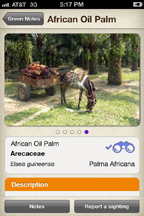New Purdue-developed mobile app helps identify tropical plants of Costa Rica, could be used to create other note-taking apps
August 23, 2012
 |
|
This screenshot taken from the Green Notes app provides an
image and description of the African oil palm, which is found in Costa Rica.
(Purdue News Service photo) |
WEST LAFAYETTE, Ind. — Some pictures may be worth a thousand words, but when it comes to plant identification, a snapshot rarely tells the full story.
Purdue agronomist Lori Unruh Snyder is well aware of the spatial and informational limitations of printed materials. Unruh Snyder, an assistant professor, realized the true limitations of photo sharing when publishing a field guide to tropical plants. The pocket-sized book was perfect for field use, but many of the supplemental photos and more detailed plant descriptions she'd collected through years of research had to be sacrificed for portability. She couldn't find a good digital guide either, so she decided to make her own mobile application, and she wanted some help.
Unruh Snyder partnered with ITaP technology consultants to create Green Notes, a mobile app that will help students, tourists, and plant enthusiasts search for and take notes about plants they see. While Green Notes is specific to plants, it's built on a platform that can be used to create other photographic note-taking applications in various fields for faculty who are interested in partnering with ITaP.
In addition to providing a digital, searchable plant library, Green Notes allows users to contribute to the resource by capturing plant images and sending them to their personal email or to their desired instructor. The app also contains useful information about the foods in the country to help individuals identify risks and benefits of eating certain plants.
The app was named Green Notes because it represents a new way to digitally catolog plants and keep notes in a paperless, environmentally friendly way. Other key Green Notes functionalities include auto-geotagging of plant locations and a full listing of plant sub-properties, such as medicinal or holistic uses. The app retails on iTunes for $3.99 - a fraction of the cost of most plant identification textbooks - and is easily portable, unlike a heavy textbook. The app currently lists 95 plants with 260 high-quality color images and is increasing in size.
"What we're really trying to do is educate the general public on the plants in Costa Rica and their uses, as eco-tourism is a huge part of the country," Unruh Snyder says. "The application will be very important for tour guides and will help them explain plants to their clients, why the plants are seen where they are in the country, and what they are used for."
To collect data and provide the most relevant and up-to-date content, Unruh Snyder frequently travels to Costa Rica. She also shares her passion for the country by leading study abroad excursions on sustainable agriculture food systems.
"Many people don't know, for example, that pineapples grow as a ground-dwelling herbaceous fruit and not on a tree, that avocados contain a substance that can prevent hair from turning gray, or that cashews have been used to treat fever and sweeten breath," Unruh Snyder says. "The app is not only a wonderful educational resource, but it benefits students, in particular, by giving them more confidence in their skills to understand and communicate about the plants around them when they're participating in our study abroad trips. My students and I used the Green Notes app on a daily basis when we visited Costa Rica this past May."
 |
|
Lori Unruh Snyder |
Having previously partnered with ITaP on the creation of iFARM, an interactive, multimedia simulation of agricultural learning modules, Unruh Snyder is a proponent of adopting new technologies into her curriculum to boost student interaction, which she believes benefits learning.
"In many cases, a single snapshot of a tree, vine or flower looks nothing like the plant in its natural environement, so it often stumps my students when they attempt to identify a specimen in the field," she says. "For students who don't speak Spanish, Green Notes also bridges the communication gap by enabling them to communicate through images, and provides the common Spanish name of which it is called in Costa Rica. With this technology you can zoom in on a photo to see additional morphological details that are helpful when identifying the plant."
Moreover, Unruh Snyder has the ability to update the app with new information as it becomes available, which costs less and is faster than updating a book. The platform also may be expanded to incorporate plants from other regions, and the technology can be applied to field guide material from other faculty.
Kyle Bowen, ITaP's director of informatics, who worked with Unruh Snyder to create Green Notes, encourages faculty to contact him to discuss additional opportunities in bringing mobility and interactivity to the classroom. While several ITaP-developed mobile applications already are available for broad use, Bowen and his team are interested in working with instructors to develop new teaching technologies.
"We want to partner with instructors in creating new tools that enhance the learning and teaching experience, both within and outside of the classroom." Bowen says. "Our students live in a mobile world. We can accommodate them by employing technology that students already own and understand, while reducing the cost of educational materials and improving student engagement and access to information."
Writer: Andrea Thomas, 765-496-8204, thomas78@purdue.edu
Sources: Kyle Bowen, 765-496-7486, kbowen@purdue.edu
Lori Unruh Snyder, 765-496-3204, ljsnyder@purdue.edu
Related links:
Green Notes Costa Rica: http://itunes.apple.com/US/app/id543927609?mt=8

